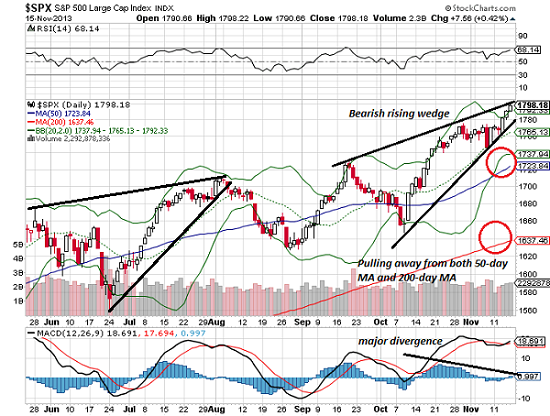Since late 2012 Zero Hedge has been very critical of Japan’s Abenomics experiment, and its first and only real arrow: a massive increase in the monetary base thanks to the BOJ’s shock and awe QE announced in April, resulting in the collapse of the Yen (although in a not zero sum world this means ever louder complaints from US exporters such as Ford competing with Japanese companies), a soaring Nikkei (if only through May), and what was expected to be an economic renaissance as a result of a return to stable 2% inflation.
We repeatedly warned that the only inflation anyone would see in Japan is in imported energy costs and food prices, which in turn would crush real disposable income especially once nominal wage deflation accelerated, which it has for the past 16 months straight. So far this has happened precisely as warned.
Another thing we warned about is that the result of the bank reserves tsunami – just like in the US – lending in Japan would grind to a halt, as everyone and their grandmother sought to invest the resulting excess deposits in risk markets as exemplified best by JPMorgan’s CIO division.
Today, with the traditional one year delay (we assume they had to give it the benefit of the doubt), the mainstream media once again catches up to what Zero Hedge readers knew over a year ago, and blasts the outright failure that is Abenomics, but not only in the US (with the domestic honor falling to the WSJ), but also domestically, in a truly damning op-ed in the Japan Times.
We will let readers peruse the WSJ’s “Japan’s Banks Find It Hard to Lend Easy Money: Dearth of Borrowers Illustrates Difficulty in Japan’s Program to Increase Money Supply” on their own. It summarizes one aspect of what we have been warning about – namely the blocked monetary pipeline, something the US has been fighting with for the past five years, and will continue fighting as long as QE continues simply because the “solution” to the problem, i.e., even more QE, just makes the problem worse.
We will however, show the one chart summary which captures all the major failures of the BOJ quite succinctly.
More importantly, we will repost the Japan Times Op-Ed from last night, titled “BOJ’s money mountain growing but debt may explode” because it not only copies all we have said over the past year, but is a dramatic reversal from the Japanese population eagerly drinking Abe’s Koolaid long after its expiration date. Because once the media starts asking questions, the broader population can’t be far behind.
From Japan Times, November 17, 2013 highlights ours
BOJ’s money mountain growing but debt may explode
by Reiji Yoshida
Haruhiko Kuroda hit the ground running when he was appointed by Prime Minister Shinzo Abe in March to take charge of the Bank of Japan.
Out of the blue, the central bank’s new governor unveiled a super-aggressive easing policy the next month to double the nation’s monetary base in just two years. He said the BOJ would buy more than ¥7 trillion in long-term Japanese government bonds per month to flood the financial system with money to end more than a decade of deflation.
The BOJ’s nine-member Policy Board unanimously supported Kuroda’s goal of stoking 2 percent inflation in two years — a surprise about-face from its stance under his predecessor, Masaaki Shirakawa, who was concerned about the potential side effects of embracing such radical quantitative easing.
More than six months have passed. How has the BOJ’s strategy changed Japan’s financial markets and the real economy?
Critics say Kuroda’s monetary easing scheme isn’t working, although most of the public apparently believes otherwise.
There are growing signs of inflation, but not the sort heralding the start of Abe’s much-advertised recovery and rising wages. Instead, imported fuel and other products have become more expensive because of the weak yen ushered in by Kuroda and Abe, and this bodes ill for the public’s living standards.
Meanwhile, Kuroda’s aggressive plan is allowing the debt-ridden government to issue fresh bonds continuously, further increasing the likelihood of a fiscal crisis, they said.
“People have been deceived by ‘Abenomics,’ ” Yukio Noguchi, a prominent economist and adviser to Waseda University’s Institute of Financial Studies, told The Japan Times in a recent interview.
“Monetary easing is not working, and it’s going nowhere,” Noguchi said.
Since April, the BOJ has been gobbling up JGBs from banks and the open market. Its purchases amount to roughly 70 percent of the value of all new JGBs issued.
But the banks are just stowing that money in their accounts at the BOJ because they can’t find any companies interested in borrowing it.
“There is no demand for funds on the part of businesses. That’s why the monetary easing is not working,” Noguchi said.
Japan’s monetary base — the sum of cash in circulation plus banks’ current account balances at the BOJ — surged from 23.1 percent in April to 45.8 percent in October, thanks to the BOJ’s aggressive operations.
But its money stock — the total amount of monetary assets available in an economy including credit created by bank loans, but excluding deposits held by financial institutions and the central government — only rose to 3.3 percent from 2.3 percent in the period.
This means banks are just depositing the massive funds provided by the BOJ in their own accounts at the central bank. The unloaned cash is thus having little affect on the real economy.
Meanwhile, the long-term interest rate, which theoretically factors in an expected rate of inflation, has fallen and is dwindling at an ultralow level of around 0.6 percent.
This signals that the market does not yet seriously believe that inflation in Japan will reach Kuroda’s 2 percent goal, said Kazuhito Ikeo, an economics professor at Keio University.
“When the policy interest rate has effectively fallen to zero, monetary policy won’t work much any more,” Ikeo said in a recent interview.
Ikeo believes the economy is stuck in a rut because its potential for economic growth has declined and monetary measures alone can’t solve the problem, he said.
“I think it has become clearer that there is a limit to what monetary policy can do,” Ikeo said.
Much of the public believes the drastic easing measures adopted by Abe and Kuroda helped weaken the yen and benefitted exporters. The yen-dollar rate has fallen from around 78 to about 100 over the past 14 months. This helped send the Nikkei stock index soaring from December, one of the main reasons Abenomics has public support.
But the yen started depreciating last fall, long before Kuroda’s widely proposed takeover at the BOJ officially took place in April, Noguchi said.
Abe was just “lucky” to see the yen fall, Noguchi claimed, crediting the easing of the eurozone debt crisis last fall rather than clear signs that Abe’s Liberal Democratic Party was getting ready to boot the unpopular Democratic Party of Japan from power.
In September, Japan’s consumer price index rose 0.7 percent from the same month last year to log its fourth consecu
tive rise, hinting at inflation. The uptick, however, was misleading. It was largely caused by the costly rise in energy imports, exacerbated by a weaker yen.
This, of course, is not a sign of economic recovery, both Noguchi and Ikeo said.
Workers’ real wages fell 2 percent in August compared with the same month the previous year, logging two drops in a row. Inflation without wage hikes will only erode people’s living standards.
“It is wages that matter. If prices go up without a rise in wages, the real income of the people just goes down,” Noguchi said.
Abe apparently is well aware of this risk and has repeatedly urged top business leaders in Keidanren, the nation’s largest business lobby, to push for wage hikes to generate “a virtuous cycle” of raises and economic expansion.
Noguchi calls Abe’s approach “sheer nonsense” because Japan is not a planned economy and the government thus cannot force businesses to raise wages against their will.
Probably the biggest risk with Abenomics, however, is a potential crash in JGB prices that would cause long-term interest rates to spike and gut the debt-laden government.
Ikeo pointed out that the BOJ’s massive bond purchases are in fact helping the debt-ridden government finance itself, even if the central bank claims this is not its intention. If the BOJ keeps up this charade, confidence in JGBs might crash, Ikeo said.
“Soon or later, concerns over fiscal sustainability will emerge. You can’t rule out the possibility of a surge in the (long-term) interest rate at a critical point,” he said.
The resulting surge in debt-serving costs would devastate the government, which has already racked up a public debt totaling almost 200 percent of gross domestic product — the highest of all developed countries. Nearly half of Japan’s ¥92.6 trillion general account for fiscal 2013 is barely being financed by fresh JGB issues.
According to Noguchi’s simulation, if the average JGB yield jumps to 4 percent in fiscal 2014, debt-serving costs will leap to a staggering ¥50 trillion in fiscal 2025 alone, which is more than half the size of the fiscal 2013 budget.
“This is nothing but fiscal bankruptcy,” Noguchi warned.
For some two decades, fears and rumors have swirled about just such a scenario. Economists who warned of the impending crisis were labeled alarmists while speculators who bet on it always lost.
That situation may soon change.
Japan’s trade balance has turned into a deficit and the current account surplus has shrunk. Japan posted a surplus of ¥3.05 trillion in the current account for the April-September half, the second-lowest level since 1985, when comparable data became available.
Ikeo warned that if the current account balance sinks into red and people are convinced the yen will no longer strengthen, investors may start buying foreign bonds and ditch their JGBs.
Another possible danger is, ironically, a full-fledged economic rebound, which would also push up long-term interest rates, Ikeo said.
The government needs to walk “a dangerous narrow path” of seeking a recovery while trying to prevent interest rates from surging at the same time, he said.
![]()
via Zero Hedge http://feedproxy.google.com/~r/zerohedge/feed/~3/54ep3jNUAqI/story01.htm Tyler Durden









 If you could settle the question with a
If you could settle the question with a Sousveillance is the recording of an activity by
Sousveillance is the recording of an activity by



 Update (10pm ET, November 15):
Update (10pm ET, November 15): 